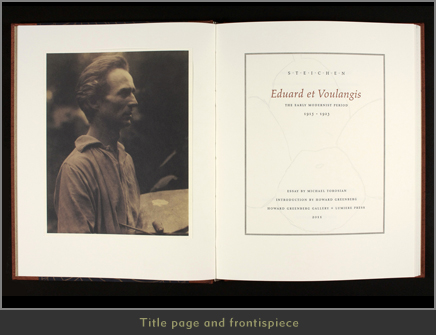





Steichen: Eduard et Voulangis
The Early Modernist Period 1915 - 1923
Essay by Michael Torosian
Introduction by Howard Greenberg
2011
In the years immediately following the First World War, Eduard Steichen retreated to his home in the village of Voulangis, on the outskirts of Paris, to meditate and rediscover himself as an artist. During a period that he would recall as a time of "deep, earnest soul-searching", the master of pictorialism would undergo a metamorphosis into modernism. He would also perform two transformative acts that would add a mythological dimension to his artistic mystique - he would destroy his work as a painter and he would photograph a cup and saucer 1,000 times. In the garden of Voulangis he would revolutionize his vision of photography.
In the autumn of 2008, Steichen's widow, Joanna Taub Steichen, disclosed to Howard Greenberg the existence of an envelope containing the earliest specimens of Steichen's modernist work - prints that had not been seen for almost a century. "An astonishing bouquet of experiments in toning and multiple-printing processes," Greenberg calls them in his introduction, "works of intellectually ambiguous abstraction - hypotheses on sensitized paper."
"Steichen was at a crossroads and longed for a refuge where he could meditate upon his future path. In the rotunda of the Gare de l'Est a boarding call echoed the name of a town in the French countryside." In this, the first book devoted to the Voulangis period, Michael Torosian charts the path of Steichen's early development as an artist, his ascent in the orbits of Paris and New York and the confluence of cultural, aesthetic and personal events that dramatically forged his work as a photographer. Three Pears and an Apple, "modernity as a visual koan", is the salient image weaving through the narrative, explicating Steichen's eclectic intellect and the diversity of influences upon his work. "Flowers, geometry, the splay of light on the rim of a cup; in Voulangis the raison d'être was exploration."
The Reproductions
To preserve the extraordinary presence of Steichen's printmaking, each plate in the book has been hand tipped onto the page. The sixteen images have been meticulously reproduced in 10 micron stochastic four-color offset lithography on Mohawk Superfine paper and varnished to emulate the finish of the originals.
Specifications
The text has been cast in lead on the Intertype model C4 using the 10 point Linotype cutting of designer Hermann Zapf's Palatino with his companion typeface Aldus for display. The lead formes were printed letterpress by hand on the Vandercook Universal III on Somerset, a 100% rag paper made expressly for this edition at the St. Cuthbert Mill in England. The endpapers, a rich stock of muted tonalities, were crafted at the Papeterie Saint-Armand in Montreal. The book measures 8 x 10 inches; 64 pages.
Slipcase and Binding
The edition has been hand bound in copper-colored Asahi Japanese silk on the spine and fore-edges. A central panel of Canal rag paper, crafted to our specifications at Papeterie Saint-Armand in Montreal, has been printed in gold with a pattern extrapolated by Michael Torosian from a nineteenth-century sketch by Koloman Moser. Presented in a handmade slipcase wrapped and lined in black Asahi bookcloth. Printed in a numbered edition of 250. Numbers 1 to 50 have been retained by the Howard Greenberg Gallery.
Awards
First Prize, Alcuin Society, Limited Edition Book Design.
Status
Out of print.